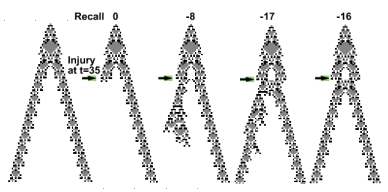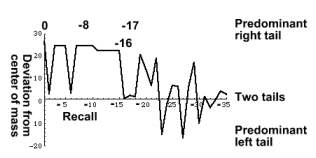 |
Regeneration during chronic injury
The experiment starts with a two tailed CA. At t = 35 the lefttmost bit of the left tail was injured ( = 0), and the CA lost its tail. From now on the CA attempts to regenerate its tail by recalling its previous experience. A similar experiment was described before when the tail was cut off, and later grew again. In the present experiment the CA has to regenerate its tail despite continuing injury at t = 35. During regeneration it recalls its previous states, and their respective age distributions.
 |
The following graph
summarizes the regeneration efforts. It depicts the deviation of the center
of mass of the regenerating CA from the center of mass of an uninjured one. A perfect regeneration ought to be symmetric, and its center
of mass, ought to equal that of an uninjured CA (deviation = 0). Only one CA (t = -16)
meets these requirements. The
CA succeeds to regenerate its tail even when injury is three bits deep.
Following more extended injury the CA fails to regenerate its tail.
 |
The CA never experienced a similar injury before. Now when attempting to regenerate its tail, it examines its past experience and
comes up with an adequate solution. Although state 19 (-16) was never injured, it knows how to regenerate an injured tail. The CA has an innate
knowledge how to repair injured tails. Its solution is creative. Kant would call
such a knowledge 'synthetic
a priori'.
This kind of regeneration was described in newts by M. Singer. When a leg of a newt is cut off, the wound is infiltrated with stem cells called blastema, which gradually regenerate a new leg. State 19 is a CA blastema.
Further reading:
Singer M. Neurotrophic control of limb regeneration
in the newt
Ann. N.Y. Acad. Sci. 228: 308-312,1974.
The experiment illustrates that CA memory is distributed Unlike
memories in conventional computers
it does not store images or data, but actions,
like how to regenerate a tail. Similar
information in a conventional computer
would require several lines of instructions. Here it is stored in state 19. Plant a zygote specified
by {rule = #600, age distribution
at t > 19} Let it live more than 35 time units. At t = 35 injure its
leftmost bit. Its state 19
will regenerate two perfect tails.
Setup
injurytime = 35; injuryrange =1-3; statetime=
34; prevstate = *; agetime = 34; prevage = *; preva[[1,*]] = a[[1,*]]; prevage[[1,*]] = age[[1,*]]; effect[1,
1, 25];